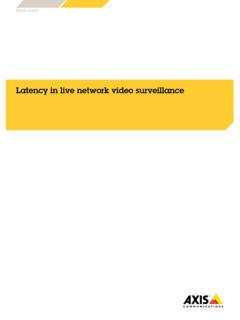Transcription of Leading indicators for assessing reduction in risk of long ...
1 Executive Health and Safety Leading indicators for assessing reduction in risk of long latency diseases Prepared by Greenstreet Berman Limited for the Health and Safety Executive 2009 RR734 Research Report Executive Health and Safety Leading indicators for assessing reduction in risk of long latency diseases Alex Rogers, Rachel Evans & Michael Wright Greenstreet Berman Limited Fulcrum House 5 Southern Court South Street Reading Berkshire RG1 4QS The HSE need meaningful Leading indicators that provide a real-time measure of progress in reducing long latency occupational disease.
2 This report provides a review of potential Leading indicators for long latency occupational disease. The work involved a literature review and 49 stakeholder interviews. The understanding of Leading indicators was mixed. Many stakeholder respondents, including some insurers, brokers, firms and health and safety institutes were unaware of the term or of examples of Leading indicators , whilst industries working with silica (mines, quarries) and chemicals (oil, gas and chemicals); and certain overseas regulators, had well developed thinking and tools. The review identified a range of indicators covering Occupational Health Management Systems, Key Performance indicators , implementation of workplace risk controls and worker surveys of awareness, attitudes and behaviours that could be implemented in existing HSE and industry tools.
3 The review identified little work on the predictive validity of Leading indicators for assessing the reduction in long latency diseases but suggested approaches to further develop this, including the use of expert judgement. This report and the work it describes were funded by the Health and Safety Executive (HSE). Its contents, including any opinions and/or conclusions expressed, are those of the authors alone and do not necessarily reflect HSE policy. HSE Books Crown copyright 2009 First published 2009 All rights reserved. No part of this publication may be reproduced, stored in a retrieval system, or transmitted in any form or by any means (electronic, mechanical, photocopying, recording or otherwise) without the prior written permission of the copyright owner.
4 Applications for reproduction should be made in writing to: Licensing Division, Her Majesty s Stationery Office, St Clements House, 2-16 Colegate, Norwich NR3 1BQ or by e-mail to ii CONTENTS Executive Summary vii-ix 1 INTRODUCTION .. 1 1 The HSE s disease reduction 1 What is a Leading indicator ? .. 2 The Leading lagging indicator spectrum .. 3 A health AIM OF THIS PROJECT .. 5 2 STAKEHOLDER CONSULTATION .. 6 Who were Recruitment .. 6 Proforma .. 6 Process .. 7 LITERATURE 7 Sources .. 7 Search 8 8 3 SYNTHESIS OF FINDINGS .. 9 INTRODUCTION.
5 9 UNDERSTANDING OF Leading How sophisticated is the understanding of Leading indicators ?.. 9 What is thought to be the role of Leading indicators ? .. 9 Range of Challenges of applying Leading indicators ? .. 10 EXAMPLES OF Leading 11 What sorts of industry sectors have Leading indicators ? .. 11 Do insurers or brokers offer new insights into long term latency predictions? .. 14 Do overseas regulators or OH bodies offer examples of Leading indicators or good practice?..15 iii Are there examples of health surveillance or workplace exposure monitoring being used as Leading indicators ?
6 16 PREDICTIVE VALIDITY OF indicators .. 17 WHAT SCHEMES COULD BE FURTHER DEVELOPED BY THE HSE? .. 18 Occupational health management indicators .. 19 KPIs -Self reporting Inspection based schemes ( Risk Control indicators ) .. 23 Survey based approaches ( WHASS) .. 25 4 CONCLUSIONS AND RECOMMENDATIONS .. 27 UNDERSTANDING OF Leading indicators .. 27 indicators AND SCHEMES THAT CAN BE FURTHER DEVELOPED .. 27 RECOMMENDATIONS .. 28 assessing THE VALIDITY OF Leading indicators FOR LONG latency 5 APPENDIX A LITERATURE REVIEW .. 31 GENERAL RESEARCH ON Leading VERSUS LAGGING indicators .
7 31 What are Leading and lagging indicators ?.. 31 Differences between Leading and lagging indicators .. 31 Examples of Leading 32 Variations of Leading indicators .. 33 Health versus Safety .. 33 NATIONAL STUDIES AND 34 35 37 Nordic .. 38 New Zealand & Europe .. 42 SECTOR LEVEL .. 44 Mining and 44 Oil and Gas .. 48 Other .. 51 AUDITS, STANDARDS AND 52 General Health and Safety .. 52 iv Occupational 52 Sector 53 MISCELLANEOUS General health and safety .. 58 Occupational 60 HSE EXISTING WHASS .. 62 CHASPI.
8 62 HASPI .. 63 Risk Control indicators .. 63 REFERENCES .. 67 6 APPENDIX B STAKEHOLDER INSURERS .. 72 What is understood by a Leading indicator ? .. 72 Practical application .. 74 UK FIRMS .. 75 What is understood by a Leading indicator ? .. 75 Practical application .. 83 TRADE 88 What is understood by a Leading indicator ? .. 88 Practical application .. 88 HEALTH AND SAFETY INSTITUTES AND AUDITORS .. 89 What is understood by a Leading indicator ? .. 89 Practical application .. 90 What is understood by a Leading indicator ? .. 91 Practical application.
9 94 7 APPENDIX C STAKEHOLDER TELEPHONE INTERVIEW PROFORMA .. 97 v vi Executive Summary The Health and Safety Executive s (HSE) Disease reduction Programme aimed to bring about behavioural change in key industries which would lead to reductions in cases of occupational diseases caused by exposure to harmful substances. For example, reductions in diseases such as dermatitis, asthma, cancer and Chronic Obstructive Pulmonary Disease (COPD is desired. However, the latter two conditions manifest themselves a considerable time after exposure to the associated harmful substances.)
10 Therefore this presents a challenge when it comes to assessing the success of the programme over the short term . The HSE need meaningful Leading indicators for the relevant sectors or activities that provide a real-time measure of progress in reducing exposure. These would then be used as reliable evidence that the incidence of occupational disease will be reduced in the long term. Aims and method This work therefore aims to provide an initial picture of: What is understood by industry/business of the concept of Leading indicators ?
















